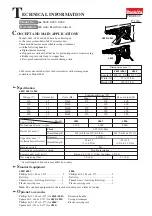
83-507-013 Rev. A
41
5.15 PARALLEL OPERATION
Up to four units of the same VOLTAGE and CURRENT rating can be connected in parallel to provide up
to four times the Output Current capability. One of the units operates as a Master and the remaining
units are Slaves. The Slave units are analog programmed by the Master unit. In remote digital operation,
only the Master unit can be programmed by the computer, while the Slave units may be connected to the
computer for voltage, current and status readback only. Follow the following procedure to configure mul-
tiple supplies for parallel operation. Refer to Sec. 5.15.1 and to Sec. 5.15.2 for detailed explanation.
5.15.1 Basic parallel operation
In this method, setting the units as Master and Slaves is made by the rear panel J1 connections and the
setup switch SW1. Each unit displays its own output current and voltage. To program the load current, the
Master unit should be programmed to the total load current divided by the number of units in the system.
Refer to the following procedure to configure multiple supplies for simple parallel operation.
1. Setting up the Master unit
Set the Master unit Output Voltage to the desired voltage. Program the Output Current to the desired
load current divided by the number of parallel units. During operation, the Master unit operates in CV
mode, regulating the load voltage at the programmed Output Voltage. Connect the sensing circuit to lo-
cal or remote sensing as shown in Fig.5-4 or fig.5-5.
2. Setting up the Slave units
-1.
The Output Voltage of the Slave units should be programmed 2-5% higher than the Output Volt-
age of the Master unit to prevent interference with the Master unit’s control. The Output Current set-
ting of each unit should be programmed to the desired load current divided by the number of parallel
units.
-
2. Set the rear panel setup switch SW1 position 2 to the up position.
-
3. Connect a wire jumper between J1-8 and J1-12 (refer to Table 4-4).
-
4. Connect J1 terminal 10(IPGM) of the slave unit to J1 terminal 25(P) of the master unit.
During operation, the Slave units operate as a controlled current source following the Master Output Cur-
rent. It is recommended that the power system be designed so that each unit supplies up to 95% of its
current rating because of the imbalance which may be caused by cabling and connection voltage drop.
3. Setting Over Voltage protection
The Master unit OVP setting should be programmed to the desired OVP level. The OVP setting of
the slave units should be programmed to a higher value than the Master OVP. When the Master unit
shuts down, it programs the Slave unit to zero Output Voltage. If a Slave unit shuts down (when its
OVP is set lower than the Master Output Voltage), only that Slave unit would shut down, and the re-
maining Slave units would supply all the load current.
4. Setting Foldback protection
Foldback protection, is desired, may only be used with the Master unit. When the Master unit shuts
down, it programs the Slave units to zero Output Voltage.
5. Connection to the load
In parallel operation, power supplies can be connected in local or remote sensing. Refer to Fig. 5-4
and 5-5 for typical connections of parallel power supplies. The figures show connection of two units,
however the same connection method applies for up to 4 units.
5.15.2 Advanced parallel operation
In this method, multiple supplies can be configured to parallel operation as a single power supply. The
total load current and output voltage are displayed by the Master unit and can be readback from the
Master unit. The Slave units display only their operating status (On, Off or Fault condition).
Refer to the following procedure to configure multiple supplies for Advanced parallel operation.
1. Basic configuration.
















































